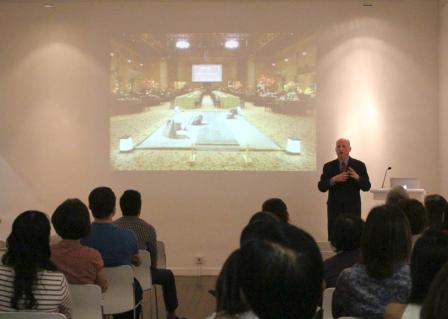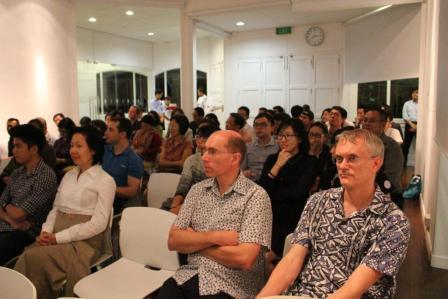
On 6th February, the CEO of Portland Japanese Garden Mr Stephen D. Bloom presented a lecture entitled Japanese Gardens: A Living World Heritage at Japan Creative Centre, under the invitation of Director Ms Misako Ito. A series of books on Japanese Zen gardens from Tuttle Publishing were exhibited in conjunction with the lecture as well.
Mr Bloom began by introducing the background, design elements and challenges of Portland Japanese Garden. Located in the west hills of Portland, Oregon with a 5.5-acre compound, the garden has been a trailblazer since its opening in 1967 as the first traditional garden to be built outside of Japan after World War II. Despite initial tensions and anti-Japanese sentiments among the Americans, many Portlanders eventually saw the garden as a cultural salve and business asset. Today, the garden composes of five different design styles, namely a Strolling Pond Garden, a Tea Garden, a Natural Garden, a Flat Garden, and a Sand and Stone Garden.
Following which, Mr Bloom talked about how they have been positioning the garden into more than just a garden, a place where people can not only vist and enjoy, but to gather and learn about Japanese culture. Ever since the garden has its own curator and developed a team of delicated volunteers, they have organised numerous Japanese-related educational and cultural events. These events include educational progammes on Japanese culture, ikebana workshops, tea ceremonies and art exhibitions.
Mr Bloom further discussed about how the garden have been connecting with the Japanese community as well. The garden was served as a place for Portlanders during the Tohoku disaster, where they pray together for Japan and they have sent messages of love and hope to Tohoku. They have also been working to track and return portions of the Japanese shrine gates that were washed ashore along Oregon coast after the tsunami.
Mr Bloom also mentioned they are coming up with an initiatives to establish an international institute for Japanese garden arts and culture at Portland Japanese Garden. The institute is to serve the urgent need for professional training and preservation on Japanese garden arts in North America. The lecture ended with a Question-and-Answer session, where Mr Bloom had an overwhelming discussion with some of the guests.
 
|